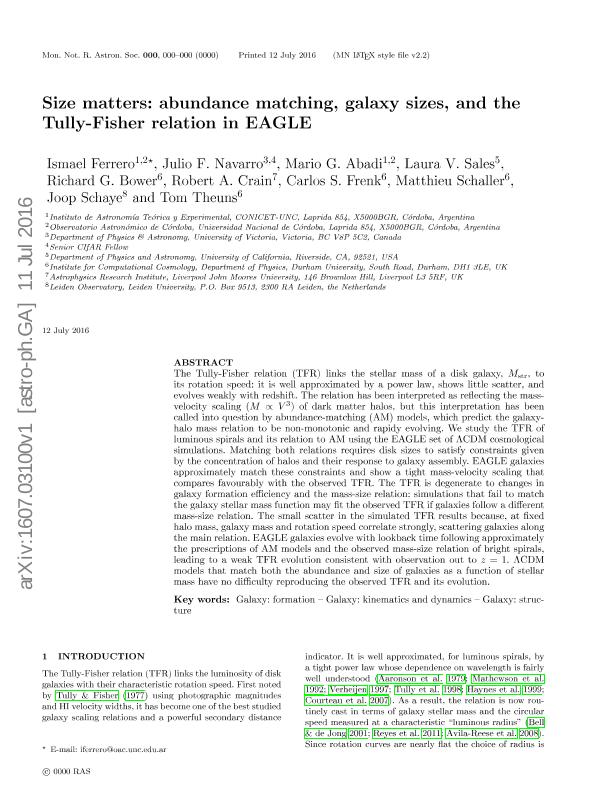Artículo
Size matters: Abundance matching, galaxy sizes, and the Tully-Fisher relation in EAGLE
Ferrero, Santiago Ismael ; Navarro, Julio F.; Abadi, Mario Gabriel
; Navarro, Julio F.; Abadi, Mario Gabriel ; Sales, Laura Virginia
; Sales, Laura Virginia ; Bower, Richard; Crain, Robert A.; Frenk, Carlos S.; Schaller, Matthieu; Schaye, Joop; Theuns, Tom
; Bower, Richard; Crain, Robert A.; Frenk, Carlos S.; Schaller, Matthieu; Schaye, Joop; Theuns, Tom
 ; Navarro, Julio F.; Abadi, Mario Gabriel
; Navarro, Julio F.; Abadi, Mario Gabriel ; Sales, Laura Virginia
; Sales, Laura Virginia ; Bower, Richard; Crain, Robert A.; Frenk, Carlos S.; Schaller, Matthieu; Schaye, Joop; Theuns, Tom
; Bower, Richard; Crain, Robert A.; Frenk, Carlos S.; Schaller, Matthieu; Schaye, Joop; Theuns, Tom
Fecha de publicación:
02/2017
Editorial:
Wiley Blackwell Publishing, Inc
Revista:
Monthly Notices of the Royal Astronomical Society
ISSN:
0035-8711
e-ISSN:
1365-2966
Idioma:
Inglés
Tipo de recurso:
Artículo publicado
Clasificación temática:
Resumen
The Tully-Fisher relation (TFR) links the stellar mass of a disc galaxy, Mstr, to its rotation speed: it is well approximated by a power law, shows little scatter, and evolves weakly with redshift. The relation has been interpreted as reflecting the mass-velocity scaling (M ∝ V3) of dark matter haloes, but this interpretation has been called into question by abundance-matching (AM) models, which predict the galaxy-halo mass relation to deviate substantially from a single power law and to evolve rapidly with redshift. We study the TFR of luminous spirals and its relation to AM using the EAGLE set of Λ cold dark matter (ΛCDM) cosmological simulations. Matching both relations requires disc sizes to satisfy constraints given by the concentration of haloes and their response to galaxy assembly. EAGLE galaxies approximately match these constraints and show a tight mass-velocity scaling that compares favourably with the observed TFR. The TFR is degenerate to changes in galaxy formation efficiency and the mass-size relation; simulations that fail to match the galaxy stellar mass function may fit the observed TFR if galaxies follow a different mass-size relation. The small scatter in the simulated TFR results because, at fixed halo mass, galaxy mass and rotation speed correlate strongly, scattering galaxies along the main relation. EAGLE galaxies evolve with lookback time following approximately the prescriptions of AM models and the observed mass-size relation of bright spirals, leading to a weak TFR evolution consistent with observation out to z = 1. ΛCDM models that match both the abundance and size of galaxies as a function of stellar mass have no difficulty reproducing the observed TFR and its evolution.
Palabras clave:
Galaxy: Formation
,
Galaxy: Kinematics And Dynamics
,
Galaxy: Structure
Archivos asociados
Licencia
Identificadores
Colecciones
Articulos(IATE)
Articulos de INST.DE ASTRONOMIA TEORICA Y EXPERIMENTAL
Articulos de INST.DE ASTRONOMIA TEORICA Y EXPERIMENTAL
Citación
Ferrero, Santiago Ismael; Navarro, Julio F.; Abadi, Mario Gabriel; Sales, Laura Virginia; Bower, Richard; et al.; Size matters: Abundance matching, galaxy sizes, and the Tully-Fisher relation in EAGLE; Wiley Blackwell Publishing, Inc; Monthly Notices of the Royal Astronomical Society; 464; 4; 2-2017; 4736-4746
Compartir
Altmétricas



